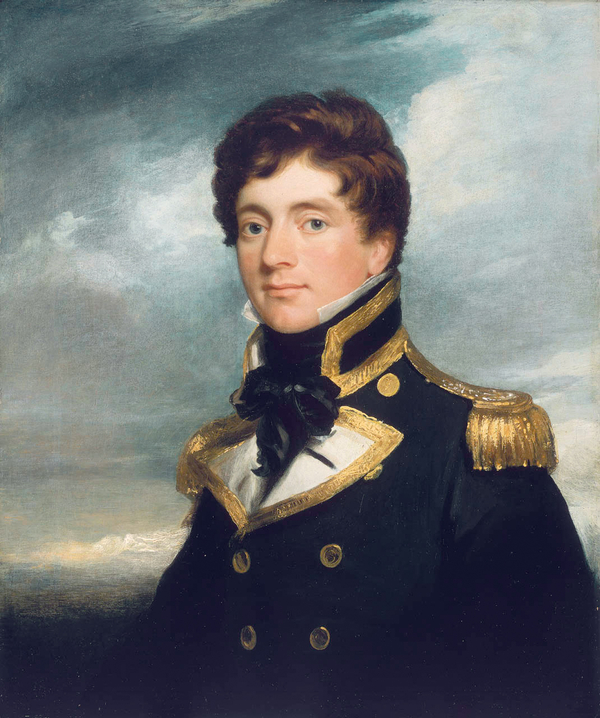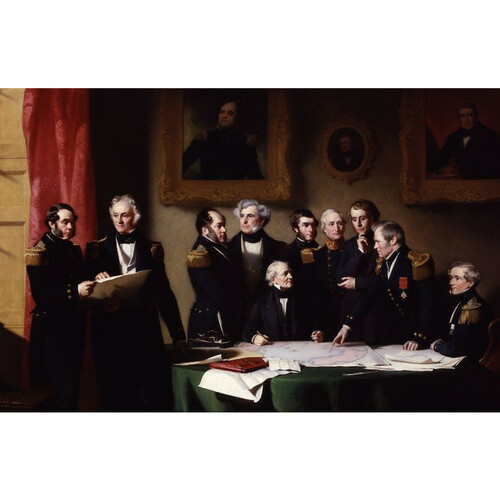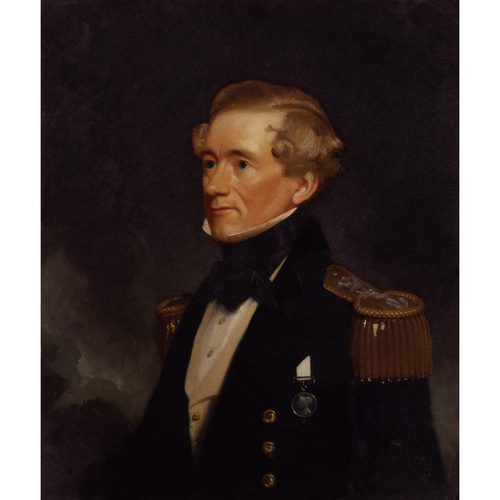
Source: Courtesy of Wikimedia Commons
BEECHEY, FREDERICK WILLIAM, naval officer, artist, explorer, hydrographer, and author; b. 17 Feb. 1796 in London, son of Sir William Beechey and Phyllis Ann Jessup; m. December 1828 Charlotte Stapleton, and they had five daughters; d. 29 Nov. 1856 in London.
Frederick William Beechey came from an artistic family, his father being a well-known portrait painter and member of the Royal Academy of Arts and his mother an accomplished painter of miniatures. Two of his brothers became recognized artists and Frederick William applied his own talents in sketching to the illustration of his naval expeditions. The artistic tradition of the family was later carried on by one of Beechey’s daughters, Frances Anne*, who spent a number of years in Canada. Beechey apparently had no formal schooling, but he probably received a certain artistic training from his family. At the age of ten he entered the Royal Navy under the direct patronage of the Earl of St Vincent, first lord of the Admiralty, and on 8 Jan. 1807 was rated midshipman. He served aboard several ships on foreign service and in January 1815 took part in the attack on New Orleans, distinguishing himself in a boat action against the American lines. In recognition of this service he was appointed lieutenant on 10 March 1815.
In 1818 the British navy renewed attempts to discover a northwest passage to the Pacific, suspended since the discoveries of James Cook*. In January of that year Beechey was appointed as second in command and chief draftsman to the brig Trent, commanded by Lieutenant John Franklin*. With the barque Dorothea, the Trent formed an expedition under Captain David Buchan* with orders from the Admiralty to search for a passage “by a northern course across the Pole.” Simultaneously a second expedition was dispatched under Commander John Ross and Lieutenant William Edward Parry to proceed through Baffin Bay. Leaving the Thames on 25 April, the Trent and the Dorothea sailed northwest of Spitsbergen as far as 80°34´N where they became jammed in the ice. After three weeks the two crews finally succeeded in freeing the vessels, and the expedition headed west towards Greenland. Unfortunately heavy gales forced the ships hard against the ice, seriously damaging the Dorothea; despite repairs, the expedition finally had to be abandoned. Both ships reached Deptford on the Thames safely on 22 October. Beechey later prepared a narrative of this expedition, A voyage of discovery towards the North Pole (1843), in which six reproductions of sketches he had done while in the Arctic were printed.
Because of his experience and demonstrated skills in navigation and sketching, Beechey was assigned to another Arctic expedition in January 1819, as second in command to Lieutenant Parry in the bomb Hecla. Parry’s instructions called for the exploration of Lancaster Sound (N.W.T.) to determine whether or not it was enclosed by a series of mountains. Setting out from London in May 1819, the Hecla in company with the gun-brig Griper reached Lancaster Sound by the end of July. They quickly determined there were no mountains, and proceeded west. By the fall of 1819 the expedition had penetrated as far as Melville Island, having discovered and named Prince Regent Inlet, Barrow Strait, Wellington Channel, and the North Georgian (Parry) Islands. The vessels wintered in Winter Harbour, Melville Island, the first time such a feat had been carried out successfully in the high Arctic; the crews occupied themselves with the development of survival techniques, the taking of magnetic and meteorological observations, the care of the ships, and leisure activities. Beechey undertook the direction of theatrical productions intended to break the monotony of the long winter, the first of these, “Miss in her teens,” being presented on 5 November. He was also a regular contributor to the North Georgia Gazette, and Winter Chronicle, a weekly newspaper edited by Captain Edward Sabine* aboard the Hecla.
In the summer of 1820 the expedition managed to proceed as far west as 113°48´22"W, discovering Banks Land (Island) to the south, sighted by Beechey, and Cape Dundas to the west, before being forced to turn back by the impenetrable ice. Heading east along the southern shore of Barrow Strait and Lancaster Sound, they charted the north coast of Somerset Island and then returned to Britain, arriving at Peterhead, Scotland, at the end of October 1820 [see Sir James Clark Ross*]. Beechey had played an important role in this expedition by assisting in navigation, taking observations, keeping notes, and drawing sketches of the Arctic scenery, 26 of which were later published in Parry’s personal narrative, Journal of a voyage for the discovery of a north-west passage (1821). During the years 1821 and 1822 Beechey was attached to a survey of the coast of northern Africa, an account of which he later published with his brother Henry William, a civilian member of the expedition. On 25 Jan. 1822, while on this survey, Beechey was promoted to the rank of commander.
In 1825 Beechey was made commander of the sloop Blossom and instructed by the Admiralty to explore uncharted areas of the Pacific, to pass through Bering Strait, and to attempt to make contact there with either an overland expedition from the Mackenzie River (N.W.T.) led by Franklin or a naval expedition from Prince Regent Inlet under Parry. During the summer of 1826 an advance party from the Blossom reached as far east as Point Barrow (Alaska) but did not meet either expedition. It was later discovered that the Blossom’s party had missed Franklin, who had come within 160 miles of Point Barrow, by only nine days. After wintering in the Pacific, Beechey once more headed north to the Bering Strait in the summer of 1827 but again failed to rendezvous with either Franklin or Parry. He then returned to the Pacific, explored and charted parts of it, and sailed home, reaching Britain in September 1828. An account of the expedition, Narrative of a voyage to the Pacific and Beering’s Strait, published by authority of the Admiralty in 1831, brought him deserved fame.
Beechey had been appointed captain on 8 May 1827, and following his return from the Pacific remained ashore for a few years. He subsequently carried out other surveys for the Admiralty, in 1835 along the coast of South America and from 1837 to 1847 along the coast of Ireland. In the latter year Beechey was appointed superintendent of the marine department of the Privy Council committee for trade, and was named to the Arctic Council, an informal body of experienced navigators assembled to advise the Admiralty in the search for Sir John Franklin, lost in the Arctic since 1845. In 1854 Beechey was promoted to rear-admiral. A fellow of the Royal Society, he was elected president of the Royal Geographical Society in 1855, a position he held until his death.
The importance of Beechey as one of the first artists and explorers of Canada’s Arctic regions is seen in the many sketches and observations he made of the territory during his voyages of exploration. Among the landmarks that bear his name is Beechey Point (Alaska), named by Parry in 1826. Contrary to popular belief, Beechey Island, off the southwest corner of Devon Island (N.W.T.), was named in honour of his father.
[Representative examples of the water-colours and pencil drawings of Frederick William Beechey are in the permanent collections of the Arctic Institute of North America (Calgary), the National Maritime Museum (London), and the Scott Polar Research Institute (Cambridge, Eng.), as well as in the archives of the Hydrographic Department of the British Ministry of Defence (Taunton, Eng.). A number of his drawings are found in W. E. Parry, Journal of a voyage for the discovery of a north-west passage from the Atlantic to the Pacific; performed in the years 1819–20 . . . (new ed., New York, 1968); in the two accounts of Beechey’s voyages, Narrative of a voyage to the Pacific and Beering’s Strait, to co-operate with the polar expeditions: performed . . . in the years 1825, 26, 27, 28 (2v., London, 1831; two further editions were published, one in London, 1831 (repr. New York, 1968), and the other in Philadelphia, 1832) and A voyage of discovery towards the North Pole, performed in his majesty’s ships “Dorothea” and “Trent” under the command of Captain David Buchan, R.N.; 1818 . . . (London, 1843); and in a work which he prepared in collaboration with his brother Henry William, Proceedings of the expedition to explore the northern coast of Africa, from Tripoli eastward; in [1821 and 1822] . . . (London, 1828).
The notes made by Beechey during his expedition to the Pacific and the Bering Strait in 1825–28 were published in two works, first in A narrative of the voyages . . . of Capt. Beechey . . . to the Pacific and Behring’s straits, performed in . . . 1825, 26, 27, and 28 . . . and of Capt. Back, to the Thlew-ee-Chola River and the Arctic Sea . . . , comp. Robert Huish (London, 1836), and then in The zoology of Captain Beechey’s voyage; compiled from the collections and notes made by Captain Beechey . . . during a voyage to the Pacific and Behring’s straits . . . , comp. John Richardson et al. (London, 1839). Beechey also prepared a chapter on hydrography in a work published by the Admiralty, A manual of scientific enquiry; prepared for the use of her majesty’s navy: and adapted for travellers in general, ed. J. F. M. Herschel (London, 1849; 2nd ed., 1851; 3rd ed., 1859). j.b.]
Gentleman’s Magazine, January-June 1857: 108–10. Cooke and Holland, Exploration of northern Canada. DNB. Daphne Foskett, A dictionary of British miniature painters (2v., New York, 1972), 1: 159. O’Byrne, Naval biog. dict. (1849), 66–67. John Barrow, Voyages of discovery and research within the Arctic regions, from the year 1818 to the present time . . . (London, 1846). S. S. Bershad, “The drawings and watercolours by Rear-Admiral Frederick William Beechey, F.R.S., P.R.G.S. (1796–1856) in the collection of the Arctic Institute of North America, University of Calgary,” Arctic (Calgary), 33 (1980): 117–67. A. M. Johnson, “Edward and Frances Hopkins of Montreal,” Beaver, outfit 302 (autumn 1971): 4–19. R. I. Murchison, “Address to the Royal Geographical Society of London; delivered at the anniversary meeting on 25th May, 1857,” Royal Geographical Soc., Journal (London), 27 (1857): xciv-cxix. G. L. Nute, “Voyageur’s artist,” Beaver, outfit 278 (June 1947): 32–36.
Cite This Article
Jim Burant, “BEECHEY, FREDERICK WILLIAM,” in Dictionary of Canadian Biography, vol. 8, University of Toronto/Université Laval, 2003–, accessed January 21, 2025, https://www.biographi.ca/en/bio/beechey_frederick_william_8E.html.
The citation above shows the format for footnotes and endnotes according to the Chicago manual of style (16th edition). Information to be used in other citation formats:
| Permalink: | https://www.biographi.ca/en/bio/beechey_frederick_william_8E.html |
| Author of Article: | Jim Burant |
| Title of Article: | BEECHEY, FREDERICK WILLIAM |
| Publication Name: | Dictionary of Canadian Biography, vol. 8 |
| Publisher: | University of Toronto/Université Laval |
| Year of revision: | 1985 |
| Access Date: | January 21, 2025 |





